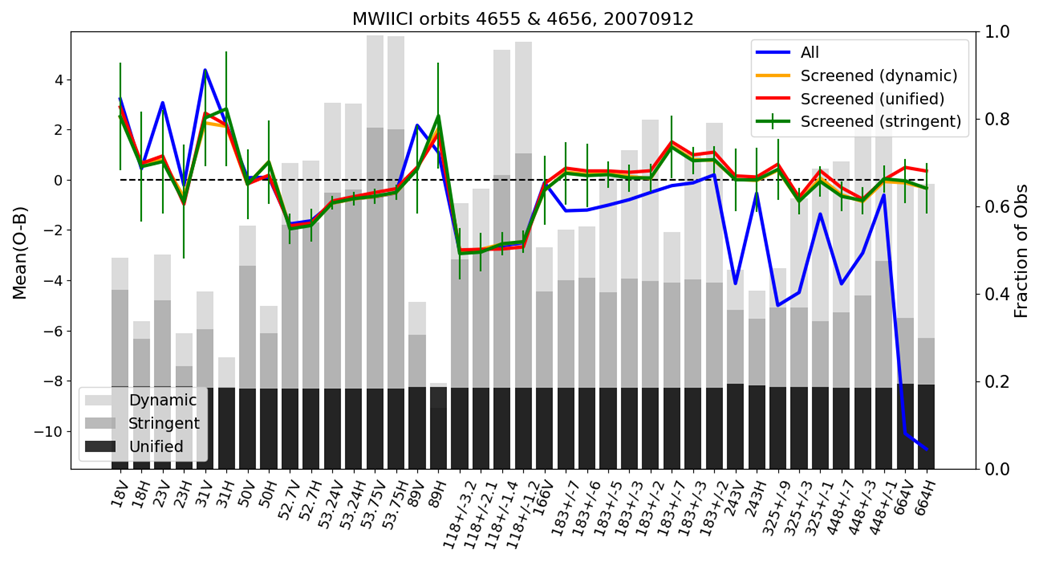07 May 2025
11 April 2025

About
Some calibration, validation and monitoring of the Microwave Imager (MWI) and Ice Cloud Image (ICI) on the EUMETSAT Polar Satellite Second Generation (EPS-SG) must be done vicariously using a radiative transfer model to simulate observations, with geophysical input data from numerical weather prediction (NWP). This task is most economically performed within an NWP system due to the large data volumes involved and because MWI and ICI observations will already be simulated from NWP inputs as part of their integration into weather forecasting process.
Objectives
The objectives of the study were:
- To develop a prototype tool for generating MWI and ICI Calibration/Validation (Cal/Val) and monitoring summary statistics and plots at ECMWF
- To develop and finalise the scientific methodology, including observation screening and the selection of plots to validate specific user requirements.
- Ultimately, to enable the required vicarious calibration and validation using the ECMWF system as soon as MWI and ICI data become available after launch.
Overview
The Microwave Imager (MWI) and Ice Cloud Imager (ICI) on board Metop-SG-B will provide extensive data to enhance our understanding of the global hydrological cycle, capturing phenomena from ice particles in the upper troposphere to intense tropical precipitation. These instruments will be the first microwave imagers launched by Europe, building on designs that have supported global estimates of precipitation since the 1980s. Crucially, they extend coverage to the previously unexploited sub-millimeter part of the spectrum, observing frequencies above 300 GHz. These new bands offer unprecedented sensitivity to atmospheric ice.
In addition to observing hydrometeors in all forms, the combined capabilities of MWI and ICI include sensitivity to surface properties, water vapour, atmospheric temperature, and ozone. This highly complementary information allows the two sensors to function as a synergistic “super-sensor”, referred to as MWIICI, which reflects how the data will be utilised at ECMWF both scientifically and technically. While the broad range of physical cross-spectral sensitivities is a major strength of MWIICI, it also poses significant challenges for traditional calibration and validation (Cal/Val) activities required for new instruments.
In this study, a method is developed for analysing the in-orbit performance of MWIICI with respect to biases. The approach involves comparing satellite observations against modelled radiances generated by a state-of-the-art numerical weather prediction (NWP) model. By examining departures (i.e., observations minus model background, or O-B) against the Integrated Forecasting System (IFS) as a reference we can assess sensor performance globally – using millions of observations each day - and easily compare results with similar sensors or other types of observations.
The monitoring is underpinned by the all-sky approach for assimilating microwave radiances, pioneered at ECMWF, and employs the RTTOV-SCATT radiative transfer model to account for the radiative effects of clouds and precipitation. The latest version of RTTOV-SCATT is used, incorporating advancements in radiative transfer developments, such as the SURFEM-Ocean emissivity model, updated sub-mm gas spectroscopy, and improved scattering properties of ice particles. By including hydrometeors in the forward model and considering the surface and cloud sensitivity for every scene, this method retains observations typically excluded by traditional clear-sky sampling methods. This results in a more balanced data sample for Cal/Val. The all-sky sampling approach maximises the data available for Cal/Val while filtering out most scenes with known model biases, such as those with thick clouds or surfaces like sea-ice and most land areas.
The sampling method employs a symmetric approach to screen out radiatively significant cloud signals by checking for the presence of clouds in both the model and the observation. This is accomplished using the cloud impact (CI) parameter, which is defined as the difference in brightness temperature (TB) between a clear scene and the TBs that are observed and modelled. Additionally, a channel-specific surface-to-space transmittance is evaluated to determine whether an observation has excessive surface sensitivity to be included in the Cal/Val sample. Because CI and surface-to-space transmittance are location- and channel-specific, the primary Cal/Val sample (stringent data selection) is optimised based on each channel's specific sensitivities to the surface and hydrometeors. A dynamic sample extends coverage over land for surface-sensitive channels to better capture the full dynamic range of MWIICI. Beyond these channel-based samples, a unified sample is defined using CI at key wavelengths, accounting for the combined sensitivities of all channels to establish a common sample. In total, three distinct data samples are defined for Cal/Val: the primary stringent sample, the dynamic sample, and the unified sample. These are applied consistently to MWIICI as well as to other microwave imagers currently assimilated at ECMWF, including GMI, SSMIS, and AMSR2.
The study explored two applications of the prototype Cal/Val approach: it’s application to two test orbits of MWIICI and it’s use with current microwave imagers. The first application provides insights into the expected sensitivities of MWIICI and demonstrates the data flow through the IFS. The second application evaluates the method’s ability to detect known sensor biases in existing sensors. For example, the analysis highlights orbital biases for F17 SSMIS, overall positive biases for AMSR2 channels, and generally small biases for GMI, all of which are well documented in the Cal/Val literature. Moreover, the method reveals previously unclear structures, such as scene-dependent biases for several channels, most notably 150 GHz on SSMIS. These findings, along with consistent geographic patterns observed between similar channels on different sensors, enhance confidence in the method. The results show that the Cal/Val sample exhibits similar patterns of atmospheric variability, despite variations in orbital characteristics and central frequencies of matched channels. Across the three data samples defined in this study, between 20% and 70% of the total data are utilised for Cal/Val analysis, depending on the channel and the sample type. Channel-specific samples retain a higher proportion of data for purely sounding frequencies, such as the 50 GHz and 118 GHz complexes, while retaining less data for frequencies like 89 GHz, which are more sensitive to surface and cloud conditions.
The performance of the MWI and ICI instruments will be monitored in near-real-time after launch, leveraging the statistical and graphical tools developed at ECMWF for monitoring the global observing system. This marks the first instance of NWP-based monitoring being specifically designed to comprehensively evaluate instrument specifications, making it an integral component of the Cal/Val activities for MWI and ICI. Key Cal/Val requirements, such as inter-channel and intra-scan bias characteristics, can be assessed almost immediately via an ECMWF-hosted website. A notable feature of this monitoring is the direct comparison with equivalent channels on the reference-quality GMI instrument, enabling a “double difference” analysis of channel biases with the ECMWF model serving as a transfer standard.
This capability will provide EUMETSAT and the global meteorological community with valuable information for valuating radiances from the MWI and ICI instruments. Additionally, the technical developments achieved through this project will support the assimilation of MWI and ICI, facilitating their early operational exploitation.

